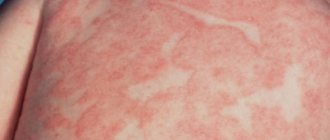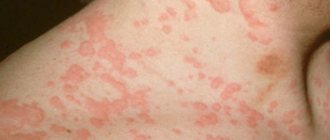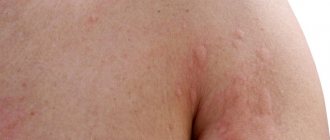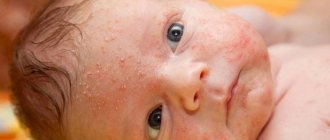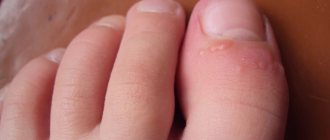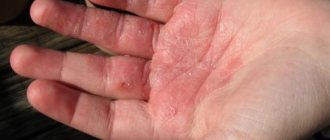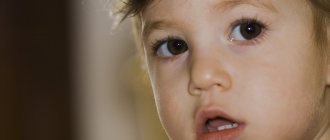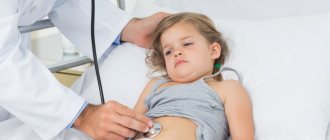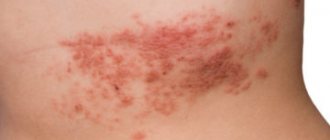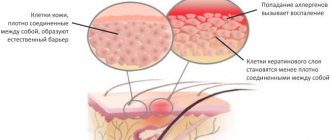Children's skin is very sensitive and quickly reacts to negative environmental factors, as well as changes in the internal systems of the body. A rash characteristic of urticaria occurs quite often in babies, with blisters appearing suddenly and disappearing just as quickly. The difficulty lies in the fact that it is often difficult to determine the true causes of itchy rashes and, accordingly, help the baby. Therefore, it is important for parents to respond in a timely manner to the manifestation of symptoms and, after consulting a specialist, begin treatment.
Programs
Boys
Hell's Kitchen
Tattoo forever
Instagrammers
all programs
Causes
Flowers are one of the possible causes of the disease
Urticaria is a common disease, but in half of the cases it is impossible to determine the exact cause of its occurrence. Once symptoms occur, a laboratory test must be taken to identify the allergen. Not all parents have this opportunity, so it is enough to know the list of foods and things that can contribute to the occurrence of hives:
- fluff, dust, pollen;
- food: brightly colored vegetables, apples, lemons, oranges, tangerines, dairy products, eggs, nuts, smoked meat and fish, seafood, honey, strawberries, chocolate;
- antibiotics and other drugs: non-steroids, analgesics, etc.
- perfumed cosmetics;
- household chemicals;
- insect bites;
- sweating;
- metal;
- Sun;
- frost, low air temperature.
The appearance of urticaria can be caused by a stressful condition, a weakening of the body's protective properties.
How to quickly get rid of a rash?
To quickly relieve the manifestations of urticaria and alleviate the condition of patients, doctors recommend the following antihistamines:
- Zodak;
- Desloratadine;
- Ebastine;
- Suprastin;
- Cetirizine;
- Loratadine;
- Fexofenadine.
Medicines should be taken as prescribed by the doctor or according to the instructions for the drug, according to the age and condition of the patient. The minimum period for taking the drug is 5 days. To relieve pain, eliminate itching and inflammation, it is advisable to wear loose clothing made from natural fabrics and sleep on cotton bedding throughout the entire treatment period.
Humidifying the air and lowering the room temperature will help ease the course of the disease. Wet soda compresses applied to itchy areas of the body have a beneficial effect. During periods of acute relapses, a careful approach to the choice of household cosmetics and personal hygiene products is required.
In case of exacerbation of the disease, patients are recommended to have a balanced hypoallergenic diet. Products that are even hypothetically capable of causing a deterioration in the patient’s condition are excluded from the daily diet. In acute cases, doctors recommend refusing to eat in the first 2 days, but drinking mineral water (up to 2.5 liters per day).
The diet for acute urticaria is followed for 1 week, for chronic urticaria - 1 month . If food allergens are identified, it is prohibited to return foods that are recognized as causative agents of the disease to the diet, even after the patient has recovered.
If the patient's condition rapidly deteriorates despite measures taken to relieve symptoms, call emergency medical services immediately. Breathing difficulties, increased swelling or a “barking” cough may be symptoms of angioedema, which in severe cases ends in death.
source
Course of the disease at different ages
Infants and toddlers suffer most from urticaria. This is due to an unformed body and delicate skin. But teenagers are also susceptible to the disease.
This means that when urticaria breaks out in children, Komarovsky offers different treatments. You need to find out the reason first .
- Newborns . Most often, hives are caused by food allergens. It usually goes away quickly. Observation by an allergist is necessary if it turns out that the baby’s urticaria is hereditary.
- Toddler age . The maximum number of diseases occurs between the ages of 1 and 3 years, as children are increasingly in contact with the environment.
- Preschoolers . Allergies to children's toys are added to all the reasons.
- Pupils . In these children, urticaria is sometimes caused by stress and the psychological state of the child, who is getting used to new circumstances and stress.
- Teenagers . Urticaria is observed after sports training with physical activity. It appears half an hour after sweating.
In this video, Dr. Komarovsky will tell you what can cause a rash in children:
Food allergies
Food allergies occur, of course, from food. Although each person’s body is individual, there is still a common group of foods that cause allergies:
- canned foods;
- products containing dyes;
- eggs;
- chocolate;
- berries (red or orange);
- fruits, also of those shades;
- fish;
- milk.
Why do allergies occur due to foods? The answer is simple - the child’s metabolism cannot yet digest all the food, so after eating allergic foods, the baby may develop a rash or hives in the form of raised redness on the body.
Due to poor production of the breakdown of substances in the body, allergies occur, sometimes even in the form of Quincke's edema. Of course, in some cases, with age, the child’s reaction to these same foods may go away, but for now, try not to eat them.
Symptoms
What urticaria looks like in children is of interest to any parent. The main signs will help you quickly recognize the disease and prevent it from developing into a complex or chronic form.
- papules and blisters of various shapes and sizes. They can be located separately or merge with each other;
- the color of the rash ranges from light pink to deep red;
- if you put a little pressure on the rash, a white spot will appear in the center;
- temperature increase. This symptom indicates that an inflammatory process has begun in the body;
- swelling;
- localization of rashes. As a rule, they appear in one place - not the cheeks, arms, legs, stomach, knee bends, etc.
- itching;
- upset stomach, swelling of the face, nausea and vomiting, fever. These are signs of a severe course of the disease.
Photo of hives on a child's legs
The manifestations are similar to other skin rashes - roseola in children, acne, prickly heat, etc. The more detailed you study them, the faster you will decide on the correct diagnosis and further treatment. How quickly does hives go away? In mild cases, within a few hours or days. If there is no treatment, the rash takes longer to resolve. Severe forms of urticaria are more difficult to treat and take longer to treat, since it is necessary to relieve a number of symptoms. Treatment for severe cases may take several weeks.
How dangerous is it and is it contagious?
It is possible to answer the question of why urticaria is dangerous in a child only after finding out the cause of the rash. The appearance of skin rashes is a reaction of the immune system to a pathogen or allergen . In this regard, we will talk about either an allergic reaction or an infection.
Urticaria in children is dangerous because it resembles the usual clinical picture of measles and scarlet fever. These are quite serious diseases that require appropriate treatment.
When contacting an infected child, other children have a fairly high risk of becoming infected .
If the cause of the rash is an allergy, then there is no need to worry about infecting other children .
However, even if tests show a reaction to an allergen, parents do not need to treat the disease with disdain.
There is no need to guess whether the hives will go away on their own or whether you need the help of specialists.
Treatment must be started as soon as possible. If there is delay, complications may arise that pose a danger to the child’s health. And it is not known how many days the hives will go away.
Possible complications usually include two :
- Angioedema . Also called “Quincke’s edema”. This phenomenon extends to subcutaneous adipose tissue and mucous membranes. In severe cases, swelling can affect the brain, nervous system, and lead to suffocation.
- Urticarial vasculitis . With this phenomenon, the patient develops large blisters all over the body, which may not go away for a long time.
Next, we suggest looking at photos of urticaria in children:
Such complications in children are much less common than in adults, but parents need to pay increased attention to the course of the disease.
The disease can manifest itself in children in two forms : acute urticaria or chronic. An acute reaction is when a child’s severe urticaria goes away, but quickly. As a rule, when contact with any allergen is stopped.
If urticaria in a child lasts for a long time and appears often, then perhaps we are talking about a chronic form. It can be caused not only by external factors, but also by dysfunction of certain organs and systems of the body.
A few facts about baby rash
- The most dangerous rash is meningococcal, which appears when infected with the microbe meningococcus. Meningitis develops, and systemic blood infection may begin. A child can die within 24 hours, but only on the condition that he is not provided with qualified medical care during this 24-hour period. If parents consult a doctor in time, the probability of avoiding a tragic outcome is close to 90%. Therefore, this combination of symptoms: high fever, vomiting, loss of consciousness and rash is a reason to quickly deliver the child to any nearby medical facility.
- Of the “childhood” diseases, the most dangerous is measles. Chickenpox and rubella are much easier and have fewer complications. Measles is not something to joke about. But if the child is vaccinated, then the disease either does not occur or occurs in a very mild form. Komarovsky recommends not avoiding measles vaccination.
- If a child is covered in a rash, household members and doctors must determine the reasons, excluding one category of relatives, friends and neighbors - pregnant women. Contact with them is strictly prohibited for the child. Any infection is very dangerous for the fetus.
- If the rash itches a lot, then you should suspect skin parasites. Visit a dermatologist and/or infectious disease specialist. Both scabies and fungal infections can be easily and quickly treated if left untreated.
Komarovsky urges parents to understand one simple truth - the causes of the rash are almost never external, but mostly always come from the inside. That is why questions about “what to anoint so that it passes” do not make logical sense. Before being examined by a doctor, there is no need to smear anything with anything, so as not to mislead the doctor. And after the examination, you can apply it if the doctor allows, but the main thing should be to eliminate the internal cause that caused the rash on the skin.
Diagnostic methods
When this disease develops, the patient or his parents are interviewed and the symptoms are analyzed.
The doctor can make a preliminary diagnosis after examining the child’s skin. A rash with urticaria is difficult to confuse with another. However, to exclude errors and establish the cause, tests are prescribed:
- stool analysis, which will help identify parasites - they can be pathogens;
- general blood test - identifies or excludes inflammatory and immune processes;
- allergy tests - skin tests to identify the pathogen;
- liver tests - to determine liver function and exclude its pathologies.
Thyroid function may be tested because the disease can be caused by hypo- or hyperthyroidism.
Treatment
The success of treating urticaria in children depends on accurate identification of the allergen. Therefore, the first thing doctors recommend is to get tested. After laboratory testing, medications are prescribed. External processing agents:
- "Fenistil";
- "Advantin";
- "Gistan";
- "Elidel"
Doctors do not recommend wiping the rash with products containing alcohol, as they can burn the skin. In difficult cases, injections and oral medications are prescribed. All medications are selected individually by the doctor, depending on the characteristics of the child’s body. In the simplest cases, they resort to folk remedies. Medicinal herbs help relieve itching, improve skin condition, and dry out pustules and blisters.
Recipes for medicinal infusions:
- Pour a handful of dried nettle flowers with 1 tbsp. boiling water, leave for 30 minutes. The infusion should be given to a child with hives in small portions throughout the day.
- Take equal quantities of dried nettle, chamomile, licorice and valerian roots. Grind the herbal mixture, measure out a large spoon, pour 1 tbsp. boiled water, leave for 45 minutes. Let your child drink the infusion in small portions throughout the day.
It is useful to wash the affected areas of the body with an infusion of medicinal herbs: chamomile, calendula, string. The infusion should be at a pleasant room temperature. What should you not do if you have hives? You should not sunbathe or swim in open reservoirs and pools. After the first symptoms appear, give your baby as much water as possible. If you are sure that the rash is a sign of hives, give your child activated charcoal. To prevent your baby from scratching the blisters, trim his nails. In most cases, the cause of itchy rashes is the foods that the baby consumed the day before. Therefore, the children's menu must be carefully analyzed and the necessary adjustments made.
Folk remedies in the treatment of urticaria in adults
How to get rid of urticaria in adults at home? There is one proven option - this is treatment with folk remedies. People have suffered from hives before, so over the years a considerable list of options has developed. Very often, even doctors do not neglect treatment with herbs and natural ingredients. Folk remedies for urticaria.
- Celery. This plant is widely used for various skin diseases. It perfectly relieves swelling, improves body tone, and has a beneficial effect on the stomach. Use freshly squeezed juice or infusion. It is recommended to drink a tablespoon of healing decoction or juice half an hour before meals. The mass of leaves is also used in the form of compresses, applied to the affected areas of the skin. In order to prepare the infusion, you need the root of the plant. It is infused in boiling water for about two hours. It relieves swelling well and has a diuretic effect.
- Nettle. Tea or an infusion is made from the leaves of this plant. To make an infusion, you need to pour boiling water (200 ml) into two tablespoons of crushed leaves. leave until completely cool. Used for compresses. Tea should be consumed several times a day. To make tea more tasty, honey is added to it if you are not allergic to it. Ice is also made from tea, which is then used to treat affected areas of the skin. Ice perfectly relieves itching and swelling.
- Valerian and hawthorn for urticaria are needed to relieve nervous tension and improve sleep. These plants are especially good when the cause of hives is stress or nervous exhaustion. It is best to take a mixture of these herbs at night - 30 drops.
- Yarrow. A decoction of this plant has an anti-inflammatory effect. It should be taken orally. The skin is treated with yarrow tincture: 20 g of raw material is infused in boiling water for half an hour. Take 100 ml before meals, three times a day. The tincture is made at the rate of 50 g of raw materials per 0.5 liter of vodka. Infuse for a week in a dark place. Then lotions are made from the filtered tincture.
- Horseradish. Has a bactericidal and anti-inflammatory effect. The juice is squeezed out of the root of the plant and mixed with honey one to one. Take a teaspoon before meals. This mixture helps remove toxins from the body.
- Mint. Its infusion has a calming effect. They drink it like tea by brewing its leaves.
- It is very useful to drink a decoction of wheatgrass root. This plant helps cleanse the blood, thereby ridding the body of accumulated toxins.
- Infusion of raspberry roots. Boil 200 g of raspberry roots for twenty-five minutes. Then leave for another hour, then drink half a glass 4 times a day.
- Dry roots of marsh calamus are ground into powder. This powder should be taken twice a day.
Finding the ideal remedy on your own is very difficult, because the signs of the disease are approximately the same, but the reason that caused such manifestations is different for each person. Therefore, it is simply impossible to do without the help of an experienced specialist.
And also the list of folk remedies includes not only decoctions and infusions of herbs, but also home-made ointments. They also consist of natural ingredients that can relieve the discomfort that the rash brings.
Celery juice can help get rid of hives
Nutrition
There is no consensus that a hypoallergenic diet plays an important role in the treatment of urticaria. At one age, a child’s body is not able to perceive a certain product, but at another it reacts to it completely harmlessly for the general state of health.
Of course, dyes, seasonings and preservatives should not be present in the children's diet. Among the foods that cause allergies are nuts, eggs, tomatoes, strawberries, and seafood. If a baby has hives, then the mother needs to monitor her diet.
New foods should be introduced into the diet gradually , at least one per week. A special diary with a menu will help you monitor how your body perceives new foods.
It will be useful for mothers to write down in it both what they themselves ate and the baby’s diet. If urticaria occurs, such recordings will allow you to quickly find out why the baby has a rash on his body.
Important ! When urticaria appears in a child, Dr. Komarovsky knows how to treat it. First of all, don’t get hung up on baby food and blame foods for the rash.
But it is not always the case. There was a case when a mother kept her child on a diet for a long time, but in fact the hives were provoked by sun rays . At the same time, sunscreen, a mandatory Panama hat with a visor, and walks in shaded parks are effective.
Cleaning the apartment plays an important role in the treatment of allergies . It will increase air humidity and rid the room of dust or pollen, which can also provoke the production of histamine and the appearance of skin rashes.
What causes hives
The pathogenesis of the disease in children of different ages may differ. As a rule, urticaria is diagnosed extremely rarely in infants under 6 months of age, and it can only be caused by an allergen entering the newborn’s body. The same factor causes the appearance of the disease in children under 2 years of age. As you get older, the causes of rashes become more diverse. Possible factors that provoke the appearance of pathology include:
- taking NSAIDs, antibiotics, sulfonamides, other medications;
- parasites in the child's body;
- viruses such as herpes, hepatitis or cytomegalovirus;
- inhalation of oxygen from fumes of household chemicals and various chemical compounds;
- venom of bees and wasps, which enters the child’s blood through bites;
- contact allergens (food, chemicals);
- blood transfusion;
- bacterial infections.
- At what temperature can inhalations be done?
- How to pump up your pectoral muscles at home
- Phosphalugel - instructions for use. What does Phosphalugel help for adults or children and contraindications
A chronic disease can lead to dangerous consequences - the development of liver diseases, suppression of adrenal function, etc. As a rule, the disease is immune in nature and is a consequence of autoimmune processes occurring in tissues and organs, or develops due to gastrointestinal diseases, leukemia, tumors. If you suspect a food allergy, you need to check your baby's reaction to the following foods:
- cheeses;
- nuts;
- eggs;
- whole milk;
- seafood;
- strawberry;
- tomatoes;
- spices, other food additives;
- citruses;
- smoked products;
- honey.
Doctor Komarovsky about herpetic sore throat in children and its treatment
Herpetic sore throat and its treatment in children became one of the topics of Dr. Komarovsky’s speech, which was generally devoted to enteroviral infections. Below is an editor-edited transcript and video of this speech. The semantic content did not undergo changes, only speech stylistic flaws were changed and explanatory inserts were added in brackets.
Entry:
The famous sore, which is called by the word (perhaps many have heard) herpangina. Please note that the word “herpangina” has nothing to do with the herpes virus. That is, if you have been diagnosed with “herpes sore throat” and prescribed medication for herpes, urgently look for another doctor, because these two words have absolutely nothing to do with each other.
What are the symptoms (of herpangina)? The appearance in the oral cavity - on the palate, on the tongue, on the uvula, on the tonsils - of small ulcers, like elements of stomatitis. All this is accompanied by high fever and sore throat. These are the classic symptoms of herpangina.
I pay fundamental attention to how sore throat differs from herpangina. Sore throat is acute tonsillitis, inflammation of the tonsils, (with it) a bunch of ulcers (appear) on the tonsils. And with herpetic sore throat, there may be one or two elements (rashes) on the tonsils, but a huge number of ulcers nearby: on the palate, on the mucous surface of the cheeks, on the tongue. This is herpangina.
The peculiarity of herpangina is that even three or four ulcers, that is, an element of stomatitis, give a high temperature. There won't be any problems if you don't get dehydrated. With herpes sore throat, there is almost always a high temperature and it is almost always painful for the child to swallow, and this is where the most important problems are associated. It’s clear that it hurts him to swallow, so we tiptoe around him and wait for him to agree to drink it. Let him drink whatever he wants, in any quantity. As a rule, warm, hot - (drinking) hurts. Please note - (you need to drink) cool solutions, any: oral rehydration products, and even sweet carbonated drinks in any quantity, compotes, we drink all this at room temperature, plus antipyretic (drugs). This is actually a treatment.
Another thing I would like to draw your attention to: as a rule, we always talk to you about the fact that with viral infections, improvement is usually observed within 5-6 days. With herpangina (the acute period lasts) it usually lasts 8-10 days. I draw your attention to this.
The specific features of enterovirus infection in these two variants (herpetic sore throat and hand-foot-mouth syndrome) are a rash in the mouth. And if there is a rash in the mouth, problems with swallowing arise. Therefore, the main problems of enterovirus infection are problems of fluid deficiency. We saw pimples in the mouth, we saw a rash - this is an enterovirus, all that is needed from you is not to force (the child) to eat, to drink in liters, and to use antipyretics symptomatically. Be patient, it will take up to 10 days.
Question: Please tell me, doctor, how to distinguish herpangina from streptococcal, and which one is more dangerous.
Answer: Streptococcal sore throat is a bacterial infection, right? It is, of course, more dangerous, because it gives a bunch of complications, but it is much simpler, because there are a huge number of excellent effective non-toxic antibiotics that do not even need to be injected, which are effective when taken orally, and if a child has streptococcal sore throat, then We have the opportunity to make him practically healthy within 24 hours. And with herpangina, well, it’s not fate. Whether you like it or not, no matter how healthy he is, you will suffer for at least a week, it will hurt to swallow, you will have a fever and it will be awkward to go out in public because there is a microbe, you know?
Therefore, the main thing is that it is scary for mom, when mom sees a rash - any kind - she clearly understands that this is not normal, and her ancestral genetic memory is triggered that diseases with rashes kill people. Because humanity remembers about deadly measles, about smallpox, about scarlet fever, which kill people. Therefore, as soon as the mother sees the rash, she becomes insane, despite the fact that there is no measles, scarlet fever is easily treated, smallpox has disappeared, but the mother is insane when she sees the rash. That’s why mom rushes to the doctors shouting: “What is this!”, and the doctor knows very well that when mom screams, what needs to be done? It is necessary to prescribe more medicine to the child, then the mother will shut up. Do you understand? Therefore, draw the right conclusions. This (herpes sore throat) is not scary, it goes away on its own in a week, maximum 10 days, if you know what to do. Do you know!
Diagnosis of the disease
It is not particularly difficult for a doctor to determine that a rash on a child’s skin is urticaria. To do this, it is enough to conduct an examination and collect a detailed history of life and the development of the disease.
Without special medical skills, the visual symptoms of urticaria can be confused with the following infections:
- measles;
- scarlet fever;
- rubella;
- meningitis.
These are life-threatening, highly contagious diseases, so if in doubt, or even worse, the rash has appeared in several family members, you should immediately seek medical help. Do not forget that urticaria is an individual reaction of the body; it cannot be contagious.
A detailed medical history plays a huge role, taking into account all previous diseases; for young children, information about the course of pregnancy and complications during childbirth is important. As well as information about the situation and surroundings.
Additional examination methods:
- general and biochemical blood test;
- Analysis of urine;
- feces to detect parasite activity;
- immunoglobulin E test.
The protocol for the management of children with urticaria does not require special tests using a panel of potential allergens unless necessary.
Up to 5 years, such tests do not provide reliable information about the cause of the disease, since there are false positive reactions to many types of antigens. If such tests are prescribed (for example, in the absence of positive dynamics in treatment), then they are carried out strictly under the supervision of an immunologist, because there is a possibility of developing an acute reaction.
Determining the cause of urticaria is not always easy, especially if the chronic, severe form occurs. The fact is that excessive sensitization during prolonged contact with an allergen leads the immune response to a state of increased aggression and a reaction can occur to factors that were previously perceived neutrally by the body.
How to distinguish it from other diseases?
Attentive parents, according to Komarovsky, are quite capable of independently figuring out what exactly has popped up on the baby’s skin—neonatal pimples or allergy rashes. In case of a food or other allergic reaction, the rash will appear on the entire body; in case of newborn acne, the rash will appear only on the face.
And now Dr. Komarovsky himself will tell us what childhood acne is, how this disease is explained and the rules of proper skin care.
An allergic rash, as a rule, gives the child a lot of unpleasant sensations: it itches, itches, the baby begins to behave restlessly, be capricious, and cry for no apparent reason. Newborn acne does not cause any intrusive or unpleasant effects, the child does not feel it.
Acne in babies can be in the form of papules (reddish lumps), comedones (whitish, seemingly “closed” rash) or pustules (reddish lumps with a light top, pus). With an allergic rash, the rashes and the areas around them have a pronounced red tint, without purulent “heads” or whitish tops.
Dr. Komarovsky recommends that when a rash is detected, carefully look at that part of the child’s bottom that is always hidden under the diaper. It does not come into contact with any allergens, and therefore if there is no rash there, then there is no point in talking about food allergies. If it is, then we are most likely not talking about harmless pimples, but a real allergic reaction.
We present to your attention another interesting thematic episode of Dr. Komarovsky’s program.
Sometimes acne is confused with prickly heat. If the baby is wrapped up and daily bathing is neglected, then the rash on the face will actually initially resemble acne (this disease is also called facial discoloration). You can distinguish it by its prevalence - miliaria spreads throughout the body faster than acne, and, as a rule, does not have purulent heads.
Even more often, acne can be confused with dermatitis. Only a doctor can determine the difference, and therefore Komarovsky recommends that in any case, show the baby to a pediatrician.
Komarovsky's technique
The basis of Komarovsky’s technique is data from authoritative scientific journals and recommendations of the World Health Organization. The doctor has a negative attitude towards treatment with homeopathy, drugs with unproven effectiveness, and he is skeptical about traditional medicine. Urticaria, according to Dr. Komarovsky’s definition, is a rash that manifests itself in the form of blisters on the skin, which have a clear localization and are accompanied by itching.
In some cases, it can appear on the mucous membranes, causing severe swelling. As a rule, the symptoms of urticaria disappear within a few hours after starting treatment.
As a result of certain processes, in particular changes in the capillaries of the skin, a number of substances are released, one of which is histamine. It causes certain reactions, which manifest themselves in the form of urticaria.
Frequent appearance
If the disease occurs almost every day and does not go away for more than 2 months, its chronic course is diagnosed. For most people, the cause of this disease cannot be determined. Physical factors can be aggravating.
The cause of chronic urticaria is rarely found in food, but despite this, foods have the ability to aggravate the disease. One of the main causes of a disease that does not go away for a long time is infection.
This could be, for example, candidiasis. It can also often be caused by emotional stress. In approximately 50% of cases, it resolves spontaneously after six months.
What is
Urticaria (urticaria, nettle fever or rash) is a painful condition accompanied by the spontaneous appearance of blisters or papules on the face, limbs, chest, back, causing severe discomfort and itching in the child. It has an allergic genesis and is a hypersensitivity reaction to endogenous and exogenous factors - changes occur in the blood vessels of the skin under the influence of a powerful release of histamine. This is how a rash occurs, which is actually an inflammatory swelling of the dermis.
There are acute and chronic forms of the disease:
- Acute course of urticaria . Symptoms appear sharply and bother the baby from several hours to 1-2 weeks. The blisters are usually very itchy and the affected skin becomes hot to the touch. The disease disappears without a trace as soon as it is possible to identify the allergen and eliminate contact with it.
- Chronic type of urticaria . The rash and itching are less intense, however, they are present daily for several weeks or even months. In this case, the child experiences weakness, headaches, and nausea. Neurotic disorders are also possible. Scratching itchy papules often leads to infection - dermatitis develops.
What are milia?
If the child's mother suffered from acne of various types, then the likelihood that her child will develop infantile acne remains in 30% of cases. Moreover, they are more common in boys than in girls. Such small formations are localized mainly on the face, covering the cheeks, nose, forehead, and pop up on the chin. Less commonly, they can appear on the neck, back of the head and genitals in boys.
Pimples on the face are white dots called milia or milia. They do not pose a threat to the baby’s condition and, as a rule, go away on their own with proper care.
Diagnosis and treatment are carried out in the following cases:
- find out acne or allergies in a newborn and based on this the question of whether or not to treat is decided;
- if white pimples on the face of a newborn become inflamed.
Do you need to treat hives with medication or will it go away on its own?
No, hives cannot go away on their own. This disease requires a diet and elimination of contact with various substances that can cause redness and allergies.
If the child has no complications, the disease does not require special treatment, but the doctor may prescribe antiallergic drugs such as diazolin, claretin and many others. They relieve symptoms, alleviating the general condition, but do not treat the cause.
During treatment, exclude red caviar, chocolate, all types of nuts, foods with food coloring or medications.
To exclude non-food allergies, it is worth replacing soap, shower gel and shampoo with analogues with a more natural composition.
How not to die from Quincke's edema, watch this video:
Will the rash go away on its own over time? Yes, such cases happen. Usually, after 5 years of age, a child can already eat those foods to which he was allergic at an earlier period. But there are cases when intolerance to one product remains for life.
Is it contagious or not?
No, the child can fully communicate with children if the diagnosis is made correctly.
Is it possible to walk with this disease?
Not only is it possible, but it is also necessary. But preferably in the fresh air. Then your baby will feel better, which will strengthen his immunity.
First aid for urticaria in children
First of all, it is necessary to exclude the most dangerous conditions that accompany this symptom: angioedema and anaphylactic shock.
The first condition is accompanied by severe swelling in the larynx, and the second by neurological symptoms, for example, death pangs.
In case of such a manifestation, you must immediately call an ambulance.
If the disease manifests itself only as a local reaction, it is necessary:
- take enterosorbents if urticaria is caused by food allergies.
- Remove the source of poison from an insect bite.
- Remove any irritant, chemical, cosmetic, drug, etc.
After this, you can proceed to prescribing medications.
Treatment
The best treatment is to rule out its cause and avoid it. It is also necessary to protect yourself from factors that aggravate the course of the disease. Once the cause is determined, antihistamines are prescribed to relieve symptoms.
The algorithm for prescribing drugs according to Dr. Komarovsky’s method is as follows. If one method does not help, move on to the next:
- Standard dose of 2nd generation antihistamines.
- Their dose is doubled.
- Adding another 2nd generation drug.
- 1st generation drug.
- Hormonal drugs.
- Immunosuppressants.
However, such treatment is only necessary in rare cases. Usually it is enough just to eliminate the allergen and the symptoms will go away on their own.
Drug treatment for urticaria
All parents should remember that urticaria is a serious allergic disease, and therefore, when its first signs appear, you should definitely seek medical help. The doctor will prescribe all the necessary tests and examinations that will determine the cause of the pathology.
Children are prescribed special antihistamines that reduce itching and skin rashes, and also stimulate the removal of the allergen from the body:
- Doratadine,
- Cetirizine,
- Desloratadine.
If such pharmacological agents are ineffective, glucocorticosteroids, that is, hormonal drugs, can be additionally used.
To accelerate the elimination of the allergen, enterosorbents are used - Smecta, Enterosgel. They should be given to the child for 1-2 weeks. Your doctor will advise you on the exact dosage and duration of treatment.
When is a rash on a baby’s face a reason to call a doctor?
In some cases, the appearance of rashes requires contacting a doctor:
- the child is less than six months old;
- the rash is accompanied by fever;
- the rash does not turn pale when pressed;
- after the rash, the baby's skin peels off;
- covered the whole family;
- I suspect this is a reaction to the medications.
Dr. Komarovsky asks you to remember one case when seeking help is required immediately. This is meningococcal meningitis. In rare cases, the pathogen can enter the bloodstream and begin to multiply there. The walls of the blood vessels are damaged, and a small star-shaped rash appears on the skin from internal hemorrhages. When pressed, such pimples do not lighten. This condition is also characterized by an acute onset, high fever, and may include nausea and vomiting. The disease can be treated with antibiotics, but it is important to get to the hospital on time, since it only takes a day from the first symptoms to death. Every ambulance team has the necessary medications, so it is important to report your symptoms by phone when calling the doctors.
